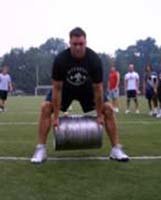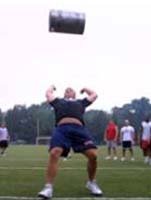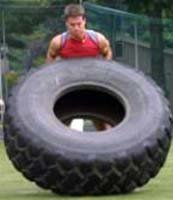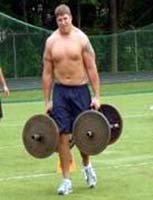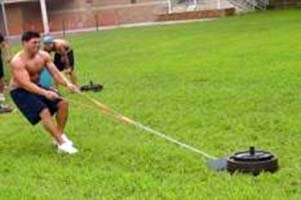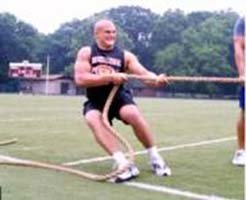
TOPIC: What Is The Best Strongman Workout?

The Question:
The strongman competition is physically demanding to the extreme. It requires years of hard work. In order to perform the heavy and awkward tasks, one needs a solid workout routine.
What is the best strongman workout? Be specific.
Is this type of workout more or less dangerous than that of a bodybuilder? How so?
Would you recommend this workout to anyone besides strongman competitors?
Show off your knowledge to the world!
The Winners:
- Squats View Profile
- Veeshmack View Profile
- jroe10 View Profile
Prizes:
- 1st place - 75 in store credit.
- 2nd place - 50 in store credit.

1st Place - Squats
View This Author's BodySpace Here.

Strongman competitors are the strongest men on the planet. They train a little bit differently from bodybuilders and powerlifters using many special tools to improve their strength such as atlas stones and the axle. They still use some of the principles in bodybuilder and powerlifter workouts such as the maximal effort, dynamic effort, and repeated effort.
Strongman train to use their muscles and be able to lift heavy weights, not to look pretty. During a cycle for an upcoming competition they train for the certain events in the competition and learn the coordination for the events. While still keeping the basic lifts in (bench, squat, and deadlift) they will cycle in a strongman exercise or event.
I prefer to use the conjugate method to structure the workouts. The conjugate method consists of three methods called the maximal, dynamic, and repeated effort.

Workout
What Is The Best Strongman Workout? Be Specific.
A few simple rules when following cookie-cutter workouts is:
- Both exercises and the weight (intensity, volume) must change over time. You want to adapt to a new stimulus, which is what makes you progress stronger and bigger.
- The training workouts must be specific to the athlete. Everyone is different, not gaining on a certain exercise? Dump it for another exercise and see how well it improves over time. Don't over do this though, change only the things that are necessary.
You also want to make sure that your nutrition is clean and enough to gain weight (which should be your main goal). I recommend eating 1.5-2 grams of protein per day, carbs after exercise but kept fairly low (depends how tolerant you are), and high healthy fats.
| PROTEIN CALCULATOR |
I follow a lot of John Barardi's philosophy with nutrition. Here are a few principles from his book Gourmet Nutrition:
| GOURMET NUTRITION - By John Berardi | |
|

The Workout
With strongman training you need to practice the events. This will require you to look around for equipment or to find someone near you with strongmen equipment who is willing to help you out. The equipment you will want to look into is:
- Log
- Farmers walk
- Tires
- Thick bar or "axle"
- Atlas stone
- Kegs
- Rope and harness
- Dragging sled
- Yoke
- Sandbag
Some common events at a strongman competition will be:
- Log/Viking/axle press
- Deadlift with a constant weight
- Car/Tire flipping
- Stone loading
- Farmer walk
In your training cycle you will want to add in events specific to what you will be doing in the contest.
As an example for the workout, we'll say the contest has log lift, sled dragging, atlas stones, tire flip, and farmers walk as the events.
We'll structure the training around a two-week rotation.
 Monday:
Monday:
- Deadlift variation
- Overhead press variation
- Good morning variation
- Core work: abs, lower back, glutes, and hams
 Click Here For A Printable Log Of Monday.
Click Here For A Printable Log Of Monday.
 Wednesday:
Wednesday:
- Squat variation
- Bench pressing variation
- Rowing variation
- Core work
 Click Here For A Printable Log Of Wednesday.
Click Here For A Printable Log Of Wednesday.
 Thursday:
Thursday:
- Accessory lifts
- Injury prevention
 Click Here For A Printable Log Of Thursday.
Click Here For A Printable Log Of Thursday.
 Saturday - Events
Saturday - Events
 Monday:
Monday:
- Squat variation
- Power clean variants
- Push press
- Core work
 Click Here For A Printable Log Of Monday.
Click Here For A Printable Log Of Monday.
 Wednesday:
Wednesday:
- Deadlift variation
- Military press
- Front squat
- Core work
 Click Here For A Printable Log Of Wednesday.
Click Here For A Printable Log Of Wednesday.
 Thursday:
Thursday:
- Accessory lifts
- Injury prevention
 Click Here For A Printable Log Of Thursday.
Click Here For A Printable Log Of Thursday.
 Saturday - Events
Saturday - Events
 Monday:
Monday:
- Deadlift off 100 lb. plate work up to a 5 rep max
- Military press 3 sets 6
- Good morning 3 sets 8-12
- Reverse hyper 3 sets of 8
- Weighted abs 3 sets of 10
 Click Here For A Printable Log Of Monday.
Click Here For A Printable Log Of Monday.
 Wednesday:
Wednesday:
- Squat work up to 5RM
- Press 3 sets 5
- Bent row 3 sets of 8
- Glute ham raise 3 sets of 10
- Ab circuit 3-5 exercises 10-15
 Click Here For A Printable Log Of Wednesday.
Click Here For A Printable Log Of Wednesday.
 Thursday:
Thursday:
- Rear dealt lateral 3 sets 15
- Rotator work 3 sets 10-15
- Glute 3 sets 10
- Neck 2 sets 15
- Triceps 3 sets 10
 Click Here For A Printable Log Of Thursday.
Click Here For A Printable Log Of Thursday.
 Saturday:
Saturday:
- Log power clean and press sets of 3
- Sled drag 4 trips 20 yd.
- Stone loads 4 sets of 2 various heights
 Click Here For A Printable Log Of Saturday.
Click Here For A Printable Log Of Saturday.
 Monday:
Monday:
- Box squat set of 5 reps
- Power clean 3 sets of 3 reps
- Push press 3 sets 6 reps
- Reverse hyper 3 sets of 10
- Weighted abs 3 sets of 10
 Click Here For A Printable Log Of Monday.
Click Here For A Printable Log Of Monday.
 Wednesday:
Wednesday:
- Rack pull set of 3 reps
- Military press 2 sets of 8
- Front squat 3 sets of 4
- Reverse hyper 3 sets of 6
- Weighted abs 3 sets 10
 Click Here For A Printable Log Of Wednesday.
Click Here For A Printable Log Of Wednesday.
 Thursday:
Thursday:
- Foam roller work
- Rotator work 3 sets of 10-15
- Glute 3 sets of 10
- Triceps 3 sets of 6
 Click Here For A Printable Log Of Thursday.
Click Here For A Printable Log Of Thursday.
 Saturday:
Saturday:
- Tire flips 4 sets of 5 reps
- Farmer walk 3 sets of 30 yd. zig-zag
- 15 yd. sprints 10 sets full recovery 60 sec.
 Click Here For A Printable Log Of Saturday.
Click Here For A Printable Log Of Saturday.

Dangerous?
Is This Type Of Workout More Or Less Dangerous Than That Of A Bodybuilder? How So?
Like any other routines out there, you still have the risk of injury. You can reduce this by using proper form and not wasting yourself away going to failure. With the tools you're using in the workout risk of injury is slightly increased. Make sure you start off light and learn the form before adding weights.
The problem with bodybuilder routines are muscle imbalances. This can be corrected by using uni-lateral movements and working on weak points.
I would say that the risk is slightly increased because of the equipment you use such as a tire can fall on you if you lose your balance. Remember to always have a training partner with you and to use the correct form.

For Anyone Else?
Would You Recommend This Workout To Anyone Besides Strongman Competitors?
Cycling in events into your training cycle is a good idea. They are fun challenging and overall produce results. It has benefits for bodybuilders to get away from their normal training and to challenge themselves in a different manner. It can also help powerlifters increasing their lifts. And sports athletes can also use these to their advantage.
Here are a few links to help you out in strongman:
- http://www.ontariostrongman.ca/
- www.elitefts.com (go to the Q&A for the strongman section)
- Building your equipment
- So you want to be a strongman
Good luck!

2nd Place - Veeshmack
View This Author's BodySpace Here.

Strongman training, possibly the most demanding form of strength training out there. Not only does it take years to be at the level that these people are, but it takes intensive training.

Workout
What Is The Best Strongman Workout? Be Specific.
Strongman workouts are geared towards pure strength and explosiveness. To achieve this, you need to have strength throughout every part of your body, but also have the ability to have them all function together while exerting maximum force. As with all forms of lifting, form is key to everything; the largest factor in safety, results, and strength with strongman training.
Since you can't just go out and perform strongman workouts every day, its good to set up in a 3 day system where you would train on 3-4 days. For the example below, we will use an example 3-Day training schedule.
***ALWAYS WARMUP AND STRETCH BEFORE TRAINING IN ANY FORM
This is extremely important with strongman training. Your body is using many muscles each going through a large range of motion, so for best results, and safety, it is highly recommended that you properly warm-up with dynamic stretching.
 Monday: Strongman events:
Monday: Strongman events:
The below is copied out of DeFranco's Strongman Training:
- Overhead Keg Toss: 5 tosses rest one minute between tosses
- Tire Flip: 3 sets of 5 flips, rest 3-4 minutes between sets, or 3 sets of 30 seconds, rest 3-4 minutes between sets. (In the timed set variation, the athlete performs as many tire flips as possible in the given timeframe.)
- "Zigzag" Farmers Walk: Perform 3 sets of 50 yards around cones. Rest 3-4 minutes between sets. Remember, to WALK through this, and not force yourself to run.
- Backward Sled Drag: 2 sets of 40-50 yards. Rest one minute between sets. This is a great "finisher!"
- Tug-of-War: The tug-of-war separates the men from the boys. By the end of this workout, most guys are exhausted. Perform a two-out-of-three or three-out-of-five series to finish your workout. We rest one minute between each "war."
 Click Here For A Printable Log Of Monday.
Click Here For A Printable Log Of Monday.
 Wednesday: Full Body Workout (5x5)
Wednesday: Full Body Workout (5x5)
- Flat Bench Press Bench Press
- Bent over Rows
- Squats
- Deadlifts
- Secondary lifts are helpful, but are not necessary
 Click Here For A Printable Log Of Wednesday.
Click Here For A Printable Log Of Wednesday.
 Friday: Explosive + Olympic Workout (5x3 GO HEAVY)
Friday: Explosive + Olympic Workout (5x3 GO HEAVY)
This session will help train your muscles to work together and allow you to continue to use weights while improving your range of motion.
- Power Cleans
- Snatches
- Push Press
 Click Here For A Printable Log Of Friday.
Click Here For A Printable Log Of Friday.
***Days not mentioned are recommended off days. As strongman training can be very taxing on your body, it is ideal that you eat LOTS and get plenty of rest.

Dangerous?
Is This Type Of Workout More Or Less Dangerous Than That Of A Bodybuilder? How So?
Strongman training is a very dangerous form of training and does surpass that of bodybuilding. Because of the range of motion that you are making and the large amounts of weight you are moving your body be at greater risk of injury. This is why it is stressed that you train all your muscles together and avoid isolation exercises, as they can leave some muscles weaker than others that would result in injury.
It's simple, if someone has a lower body that's strength is far out of balance with the upper body, it is easy for injury to occur as one muscle group may give out or not be able to handle the pressure in the same manner.
An extra note for safety with strongman training, actually any training for that matter is ALWAYS, and I stress this to everyone I know, ALWAYS warm-up before training, do dynamic stretching, and NEVER static stretch before a workout. Also, always lift with a buddy, lifting alone is dangerous and without a proper spot, it can get ugly.

For Anyone Else?
Would You Recommend This Workout To Anyone Besides Strongman Competitors?
For somebody simply looking to get cut and look good, this is most likely not for you. Strongman training is exactly that, training to be strong, not to look good.
Anyone looking for strength, explosiveness, and a new workout, this is a great thing to tryout. Especially athletes. Athletes of contact sports like rugby and football always want to be tanks and more dominant on the field, this kind of training will make you exactly that as you get stronger, more explosive, and the machine you want to be.
Vivak P. (AKA Veeshmack)

3rd Place - jroe10
View This Author's BodySpace Here.


Introduction
Strongman competitions are solid end goals for pure powerlifters. These competitions focus purely on the strength of the competitor and nothing else. Even the most elite competitors seen on ESPN most nights around 2 am are far from physique champions.
I think it's safe to say that even the top tier strongman competitor would have trouble placing in even the most irrelevant small town bodybuilding competition. Then again, that's not what these guys are about.
For a bodybuilder, it's never about how much you can lift, but how much it looks like you can lift. A strongman is the exact opposite end of the spectrum. They may look like ogres, but they can sure move the weight. Which brings us to the question at hand, how do you get yourself in shape to move that kind of weight?

The Strongman Workout
In formulating a workout in preparation of a strongman competition, you are looking to formulate incredible bursts of maximum strength for very specific tasks. The key word in that sentence is bursts.
Taking a look at many of the tasks involved in a strongman competition, the vast majority of them are basically continuous 1 rep sets. For instance, when placing boulders on a pedestal one after another, you are basically doing a rep, resting while moving to the next one, and repeating. These 'bursts' of energy really put a focus on fast twitch muscle fibers.
Of course the endurance of the events require some use of slow twitch fibers, but the duration is generally such that they are not nearly as important as the fast twitch fibers. With that being said, about 80% of your workouts should concentrate on fast twitch fibers, and when it comes to training the "burst" fibers, nothing beats heavy compound movement exercises with low repetitions.
Due to the intensity of these workouts, a great deal of recovery time if also needed to insure that the muscles have adequate time for recovery and the competitor does not venture into the perils of overtraining. Therefore, a 2 day in 4 training sequence is recommended with the 2 working days being split primarily between upper body and lower body with heavy weights (as heavy as you can complete), somewhat high sets, and low repetitions with 2-3 minutes rest between each set.
Of course the upper/lower body splits are not entirely feasible due to the compound motions of many of these exercises. Also, some time should be spent in the course of each workout actually practicing strongman type events. Due to the awkwardness of some of the events in a strongman competition, actually practicing them is imperative to a good showing.
You may be able to bench 800 lbs, but if you can't hold onto a giant boulder, you're not going to do very well. A sample workout plan would be as follows:
 Day 1: Upper Body:
Day 1: Upper Body:
- Bench Press 5 sets of 4-5 reps.
- Hang and Clean: 5 Sets of 4-5 reps.
- Deadlifts: 5 Sets of 4-5 reps.
- Military Press: 5 Sets of 4-5 reps.
- Reverse Curls: 4 Sets of 12-15 reps (to increase grip strength)
- Practice Actual Strongman events.
 Click Here For A Printable Log Of Day 1.
Click Here For A Printable Log Of Day 1.
 Day 2 Rest
Day 2 Rest
 Day 3 Lower Body:
Day 3 Lower Body:
- Squats: 5 Sets of 4-5 reps
- Leg Press: 5 Sets of 4-5 reps
- Walking Lunges: 5 Sets of 10-12 steps
- Hack Squats: 5 Sets of 4-5 reps
- Practice actual strongman events.



